
Dell# show cam layer3-qos interface tengigabitethernet 2/4
Cam Port Dscp Proto Tcp Src Dst SrcIp DstIp DSCP Queue
Index Flag Port Port Marking
-----------------------------------------------------------------------
20416 1 18 IP 0x0 0 0 23.64.0.5/32 0.0.0.0/0 20 2
20417 1 18 IP 0x0 0 0 0.0.0.0/0 0.0.0.0/0 - 0
20418 1 0 IP 0x0 0 0 23.64.0.2/32 0.0.0.0/0 10 1
20419 1 0 IP 0x0 0 0 0.0.0.0/0 0.0.0.0/0 - 0
20420 1 0 IP 0x0 0 0 23.64.0.3/32 0.0.0.0/0 12 1
20421 1 0 IP 0x0 0 0 0.0.0.0/0 0.0.0.0/0 - 0
20422 1 10 0 0x0 0 0 0.0.0.0/0 0.0.0.0/0 14 1
24511 1 0 0 0x0 0 0 0.0.0.0/0 0.0.0.0/0 - 0
In the previous example, the ClassAF1 does not classify traffic as intended. Traffic matching the first
match criteria is classified to Queue 1, but all other traffic is classified to Queue 0 as a result of CAM entry
20419.
When you remove the explicit “deny any” rule from all three ACLs, the CAM reflects exactly the desired
classification.
The following example shows correct traffic classifications.
Dell#show cam layer3-qos interface tengigabitethernet 2/4
Cam Port Dscp Proto Tcp Src Dst SrcIp DstIp DSCP Queue
Index Flag Port Port Marking
-------------------------------------------------------------------------
20416 1 18 IP 0x0 0 0 23.64.0.5/32 0.0.0.0/0 20 2
20417 1 0 IP 0x0 0 0 23.64.0.2/32 0.0.0.0/0 10 1
20418 1 0 IP 0x0 0 0 23.64.0.3/32 0.0.0.0/0 12 1
20419 1 10 0 0x0 0 0 0.0.0.0/0 0.0.0.0/0 14 1
24511 1 0 0 0x0 0 0 0.0.0.0/0 0.0.0.0/0 - 0
Create a QoS Policy
There are two types of QoS policies — input and output.
Input QoS policies regulate Layer 3 and Layer 2 ingress traffic. The regulation mechanisms for input QoS
policies are rate policing and setting priority values.
•
Layer 3
— QoS input policies allow you to rate police and set a DSCP or dot1p value. In addition, you
can configure a drop precedence for incoming packets based on their DSCP value by using a DSCP
color map. For more information, see
.
•
Layer 2
— QoS input policies allow you to rate police and set a dot1p value.
Output QoS policies regulate egress traffic. The regulation mechanisms for output QoS policies are
bandwidth percentage, scheduler strict, rate shaping and WRED.
NOTE: When changing a "service-queue" configuration in a QoS policy map, all QoS rules are
deleted and re-added automatically to ensure that the order of the rules is maintained. As a result,
the Matched Packets value shown in the
show qos statistics
command is reset.
NOTE: To avoid issues misconfiguration causes, Dell Networking recommends configuring either
DCBX or Egress QoS features, but not both simultaneously. If you enable both DCBX and Egress
QoS at the same time, the DCBX configuration is applied and unexpected behavior occurs on the
Egress QoS.
798
Quality of Service (QoS)
Summary of Contents for S4820T
Page 1: ...Dell Configuration Guide for the S4820T System 9 8 0 0 ...
Page 282: ...Dell 282 Control Plane Policing CoPP ...
Page 622: ...Figure 81 Configuring Interfaces for MSDP 622 Multicast Source Discovery Protocol MSDP ...
Page 623: ...Figure 82 Configuring OSPF and BGP for MSDP Multicast Source Discovery Protocol MSDP 623 ...
Page 629: ...Figure 86 MSDP Default Peer Scenario 2 Multicast Source Discovery Protocol MSDP 629 ...
Page 630: ...Figure 87 MSDP Default Peer Scenario 3 630 Multicast Source Discovery Protocol MSDP ...
Page 751: ...10 11 5 2 00 00 05 00 02 04 Member Ports Te 1 2 1 PIM Source Specific Mode PIM SSM 751 ...
Page 905: ...Figure 112 Single and Double Tag First byte TPID Match Service Provider Bridging 905 ...
Page 979: ...6 Member not present 7 Member not present Stacking 979 ...
Page 981: ...storm control Storm Control 981 ...
Page 1103: ...Figure 134 Setup OSPF and Static Routes Virtual Routing and Forwarding VRF 1103 ...
















































